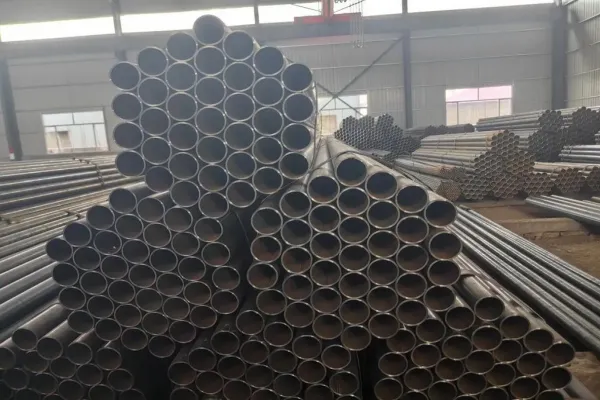Price Comparison Between Seamless Pipe and Welded Pipe
When choosing between seamless pipe and welded pipe, price is a key factor, in addition to quality, performance, and application requirements. The cost difference between these two types of pipe is due to variations in manufacturing processes, raw materials, market demand, and performance characteristics. This article provides a detailed price comparison, helping buyers make informed decisions.
1. Understanding Seamless Pipe and Welded Pipe
Seamless Pipe
Seamless pipe is manufactured by extruding a solid steel ingot into a hollow structure, followed by rolling and heat treatment processes. This process eliminates the need for welding, resulting in pipes with increased strength, uniform structure, and excellent pressure and corrosion resistance. It is widely used in oil pipelines, chemical processing, high-pressure applications, and power plants.Seamless steel pipe is a kind of pipe mainly used for fluid transportation. It is hollow in the middle and has round or square sides. It is generally made of carbon steel or stainless steel and has no seams, hence its name. It is mainly produced by rolling, drawing, extrusion or perforation. It is suitable for the transportation of most fluids, such as oil, natural gas, coal gas, water, etc.
Welded Pipe
Welded pipe is produced by rolling steel plates or coils into cylindrical shapes and joining them using welding techniques. There are several types of welded pipe, such as electric resistance welding (
ERW), longitudinal submerged arc welding (
LSAW steel pipe), and spiral submerged arc welding (SSAW). It is widely used in construction, water transportation, and structural applications due to its low cost and ease of production.
2. Why is Seamless Pipe More Expensive than Welded Pipe?
a) Manufacturing Process and Raw Material Costs
Seamless pipe manufacturing requires advanced techniques, such as hot and cold rolling, which increases production costs. In addition, high-purity steels are needed, which are more expensive than the materials used in welded pipe.
In contrast, welded pipe is produced using simpler and cheaper methods. The use of lower-cost materials and automation of welding significantly reduce production expenses, making it more affordable.
b) Strength, Performance, and Applications
Seamless pipes have better pressure resistance, greater durability, and a uniform structure, making them ideal for industries such as oil and gas, nuclear power, and aviation. However, these superior properties also increase their cost.
Welded pipes, while not as strong, have improved with modern welding technologies. They are widely used in structural and medium-pressure fluid transport applications, making them an economical choice.
c) Production Efficiency and Market Supply
Seamless pipe production is slower and more energy intensive, limiting supply and driving up prices. In contrast, welded pipe manufacturing is fast and efficient, allowing for greater market availability at lower costs.
3. Price Comparison: Seamless Pipe vs. Welded Pipe
On average, seamless pipe costs 20% to 40% more than welded pipe of the same size and material. However, price variation depends on dimensions, steel quality, and market conditions.
Small and medium diameters (less than 16 inches): Seamless pipe is considerably more expensive due to its complex process.
Large diameters (greater than 16 inches): Welded pipe is more economical, as seamless pipe production becomes less viable.
High-pressure applications: Despite its higher cost, seamless pipe is preferred for its reliability and safety.
General structural use: Welded pipe offers a more affordable alternative without compromising basic performance requirements.
4. Key Factors Influencing Prices
a) Demand and Supply Trends
Demand for seamless pipe in specialized sectors keeps prices high. In contrast, welded pipe, with a broader field of application, benefits from lower costs due to mass production.
b) Technological Advances in Welding
Modern technologies have reduced defects and improved the strength of welded pipe, closing the quality gap with seamless pipe and affecting its price in the market.
c) Fluctuations in Steel Prices
Prices for both pipes are directly affected by steel market trends, raw material costs, and energy prices.
5. Choosing between Seamless and Welded Pipe
To determine the best option, consider the following:
For projects with a tight budget → Welded pipe is the best option.
For high pressure and temperature environments → Seamless pipe offers better performance.
For large diameter applications → Welded pipe is more cost effective.
For industries such as oil and gas, chemical and power generation → Seamless pipe is more reliable.
Conclusion
Seamless pipes are more expensive than welded pipes due to their complex manufacturing process, higher raw material costs, superior mechanical properties, and specialized market demand. However, welded pipes remain the cost-effective choice for general applications, offering significant savings while maintaining sufficient performance in many industries.When purchasing steel pipes, it is essential to evaluate price, application requirements, durability, and market conditions to choose the most suitable option. By understanding the price differences between seamless and welded pipes, businesses can optimize their investments while ensuring project efficiency and performance.






 English
English Español
Español بالعربية
بالعربية











 Phone :
Phone :  Whatsapp :
Whatsapp :  Email :
Email : 


